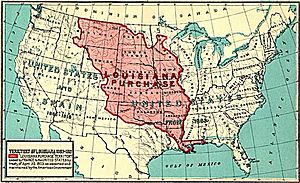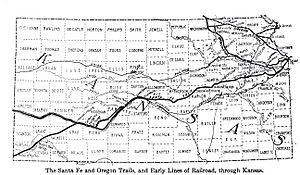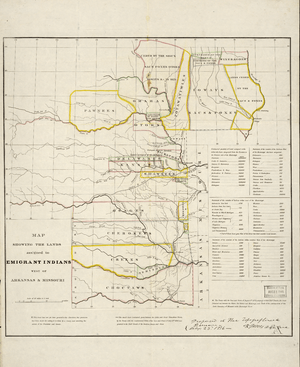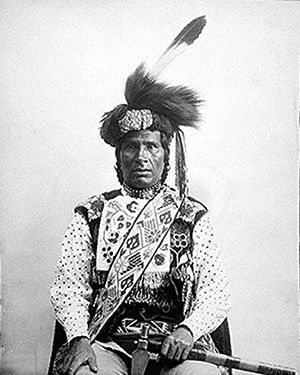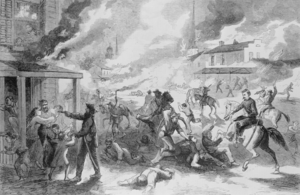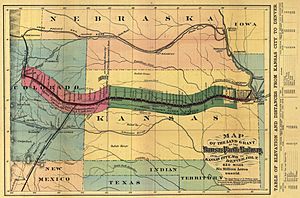History of Kansas facts for kids
| Important dates in Kansas's history |
|---|
|
The U.S. state of Kansas is located on the eastern edge of the Great Plains. Long ago, it was home to Native American tribes who hunted large herds of bison. Around 1450 AD, the Wichita People built the city of Etzanoa, which was later abandoned around 1700 AD.
Spanish explorers visited Kansas in the 1500s. Later, French fur trappers explored the area and traded with Native Americans. Most of Kansas became part of the United States in 1803 through the Louisiana Purchase. When the area was opened for settlement in 1854 by the Kansas–Nebraska Act, it became a place of conflict. This conflict helped lead to the American Civil War. Settlers from both the North and South moved to Kansas to vote on whether slavery would be allowed. Those who opposed slavery eventually won.
After the Civil War, Kansas became known for its frontier towns. Railroads in these towns were important stops for cattle drives from Texas. Many people moved to Kansas because of the railroads, including immigrants from Germany and freedmen (formerly enslaved people) called "Exodusters". Farmers first tried to grow corn and raise pigs, but this did not work well due to low rainfall. They then switched to growing wheat, which was sent to Europe.
Over time, Kansas became a strong supporter of the Republican Party. After 1945, fewer people lived on farms, and manufacturing became more important. The aircraft industry in Wichita is a good example of this change.
Contents
- Ancient Kansas: Early Peoples and Farming
- European Explorers and Native American Tribes
- The Louisiana Purchase and Early Trails
- Kansas Territory: A Time of Conflict
- Kansas Becomes a State
- Farming in Kansas
- Kansas in the 20th Century
- Sports in Kansas
- Images for kids
- See also
Ancient Kansas: Early Peoples and Farming
First Inhabitants: Paleo-Indians and Archaic Peoples
Around 7000 BC, early people, whose ancestors came from Asia, arrived in Kansas. These first Kansans stayed in the area and were later joined by other groups from different parts of North America. They found huge animals like mammoths, camels, and horses. These skilled hunters hunted large animals, which led to a rapid decline of many big ice-age mammals by 8000 BC.
After the large animals disappeared, some groups adapted. They became generalists, meaning they hunted smaller animals and gathered wild plants. Their tools changed too, with more grinding and chopping tools appearing. This showed that seeds, fruits, and greens became a bigger part of their diet. Later, people also started making pottery.
How Agriculture Changed Kansas
For a long time, people did not change their environment much. But in other places, like Mesoamerica, new ideas like growing corn spread. Some groups in North America also started growing corn on their own. About 3,000 years ago, some groups in Kansas began to grow their own food instead of just gathering it. They also started living in more permanent homes, creating larger settlements, and having burial grounds. El Quartelejo was the northernmost pueblo (a type of Native American village) in Kansas. It is the only pueblo in Kansas where archaeologists have found evidence.
Even with farming, hunting and gathering wild foods remained important for these early societies.
European Explorers and Native American Tribes
In 1541, Francisco Vázquez de Coronado, a Spanish explorer, visited Kansas. He met the ancestors of the Wichita people near the Arkansas River and the ancestors of the Pawnee near the Smoky Hill River. This was the first time Plains Indians saw horses. They later got horses from the Spanish, which completely changed their way of life and how far they could travel.
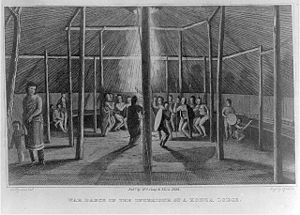
The Kansa and Osage Nation arrived in Kansas in the 1600s. By the late 1700s, these two tribes were powerful in eastern Kansas. The Kansa lived along the Kansas River to the north, and the Osage lived along the Arkansas River to the south. The Pawnee were strong on the plains to the west and north, where many bison lived.
In 1720, the Spanish military's Villasur expedition was defeated by Pawnee and Otoe warriors. This stopped Spanish exploration in the area. In 1724, French commander Étienne de Veniard, Sieur de Bourgmont visited the Kansas River and set up a trading post. The Otoe tribe also lived in parts of northeast Kansas.
The Louisiana Purchase and Early Trails
Neither France nor Spain had many settlements in Kansas. In 1763, Spain gained French claims west of the Mississippi River. In 1803, Spain returned this land to France, which then sold it to the United States in the Louisiana Purchase. Kansas became an unorganized territory of the U.S.
The Lewis and Clark Expedition explored the Louisiana Purchase in 1804. They camped for three days where the Kansas and Missouri rivers meet in present-day Kansas City, Kansas. They met French fur traders and mapped the area. In 1806, Zebulon Pike traveled through Kansas and called it "the Great American Desert" on his maps. This idea led the U.S. government to set aside Kansas for Native American resettlement for many years.
After a short time as part of the Missouri Territory, Kansas became unorganized again in 1821. That same year, the Santa Fe Trail opened across Kansas. This trail connected Missouri with Santa Fe, New Mexico, and became an important trade route. To protect travelers, the U.S. Army built posts like Fort Leavenworth in 1827.
A part of the Santa Fe Trail was also used by settlers on the Oregon Trail, which opened in 1841. These trails were vital for trade and military travel until railroads took over in the 1860s. Kansas was a key stop for travelers heading west to Utah, California, or Oregon. Important spots on the trail included Wagon Bed Spring, Point of Rocks, and Pawnee Rock.
Kansas as Indian Territory (1820s–1840s)
Starting in the 1820s, the U.S. government set aside the area that would become Kansas as Indian Territory. White settlers were not allowed to live there. The government moved Native American tribes from eastern Kansas, like the Kansa and Osage, to reservations in other areas. This opened up land for tribes from the eastern U.S. to move into Kansas.
In 1825, the Kansa Nation gave up 20 million acres of land to the U.S. and were limited to a reservation in northeast Kansas. The Osage Nation was also limited to a reservation in southeast Kansas. The Shawano (or Shawnee) from Missouri were the first Native Americans moved to this territory.
Other tribes, like the Delaware, Ottawa, and Kickapoo, also moved to Kansas through treaties in the 1820s and 1830s. The Indian Removal Act of 1830 sped up this process.
By 1836, the Sac and Fox tribes moved north of the Kickapoo. In 1837, the Potawatomi moved to an area on the Osage River. In 1842, the Wyandots moved to where the Kansas and Missouri Rivers meet. Some Wyandot families even received special land ownership rights. In 1847, the Potawatomi were moved again to a large area that is now part of Pottawatomie, Wabaunsee, Jackson, and Shawnee counties.
Kansas Territory: A Time of Conflict
Opening Kansas for Settlement (Early 1850s)
Even though Kansas was meant for Native American tribes, by 1850, white Americans were illegally settling on their land. They demanded that the entire area be opened for settlement. U.S. Army forts, like Fort Riley, were built deep in Indian Territory to protect travelers on the western trails.
The Cheyenne and Arapaho tribes were still negotiating for land in western Kansas. However, the push to settle the land was already very strong.
The Kansas–Nebraska Act
Congress began discussing creating Kansas Territory in 1852. After much debate, the Kansas–Nebraska Act became law on May 30, 1854. This act created the Nebraska Territory and Kansas Territory.
The most debated part of the act was that settlers in Kansas Territory would vote on whether to allow slavery. This rule canceled the Missouri Compromise of 1820, which had banned slavery in new states north of a certain line. This led to violence between Northerners and Southerners who rushed to Kansas to control the vote.
Native American Lands Ceded
By the summer of 1853, it was clear that eastern Kansas would soon be open to American settlers. The government negotiated new treaties with Native American tribes. Most tribes in eastern Kansas gave up large parts of their lands before the Kansas territorial act passed in 1854. Many were eventually moved south to what is now Oklahoma.
In the months before the act, treaties were made with the Delaware, Otoe, Kickapoo, Shawnee, Sac, Fox, and other tribes. This opened up most of eastern Kansas for white settlement. For example, in 1854, the Shawnees gave up 6.1 million acres, keeping only 200,000 acres for their homes. The final step in Americanizing Native Americans was to take land from tribal control and give it to individual families, so they could buy and sell it like European Americans.
An Invitation to Violence: Bleeding Kansas
After the Kansas–Nebraska Act passed, hundreds of pro-slavery Missourians crossed into Kansas. They claimed land and formed groups to make Kansas a slave state. They even said they would fight and die for it.
To fight this, the New England Emigrant Aid Company and other groups sent anti-slavery settlers, called "Free-Staters," to Kansas. These settlers founded towns like Topeka, Manhattan, and Lawrence. Many Free-State men also came from other Midwestern states.
Bleeding Kansas: The Border Wars
From 1855 to 1858, Kansas Territory saw a lot of violence and battles. This period is known as "Bleeding Kansas" or "the Border Wars." It was a direct cause of the American Civil War.
The violence began after the election for the Kansas Territorial legislature on March 30, 1855. Missourians, known as "Border Ruffians," illegally crossed the border and stuffed ballot boxes. As a result, pro-slavery candidates won almost every election district.
Major events of Bleeding Kansas included the Wakarusa War, the Sacking of Lawrence, the Pottawatomie massacre, and several battles.
- Wakarusa War: On December 1, 1855, a group of Missourians attacked the Free-State town of Lawrence. A peace agreement was eventually reached.
- Sacking of Lawrence: On May 21, 1856, pro-slavery forces led by Sheriff Samuel J. Jones attacked Lawrence. They killed two men, burned the Free-State Hotel, destroyed printing presses, and robbed homes.
- Pottawatomie Massacre:
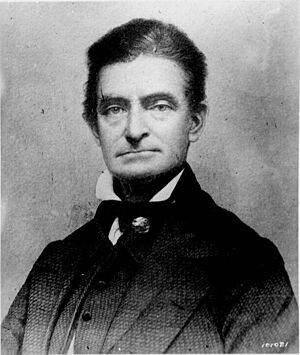
This happened on the night of May 24-25, 1856. As a reaction to the Sacking of Lawrence, John Brown and other abolitionists killed five settlers believed to be pro-slavery. Brown later approved of the killings. He then led a successful attack on a group of Missourians in the Battle of Black Jack.
Territorial Constitutions
Both pro-slavery and anti-slavery groups tried to create their own state constitutions. These documents would either allow or ban slavery. Congress had the final decision.
Topeka Constitution
The Topeka Constitution was created by Free-State delegates on November 11, 1855. It stated, "There shall be no slavery in this state." The people of the Territory approved it, but pro-slavery senators in Congress stopped it from becoming law.
Lecompton Constitution
The official pro-slavery government created the Lecompton Constitution on November 7, 1857. This constitution would have allowed slavery. After many votes that were boycotted by one side or the other, it was sent to Congress. It was eventually rejected because it was unclear if it truly represented the will of the people.
Leavenworth Constitution
While the Lecompton Constitution was being debated, a new Free-State legislature was elected. They created the Leavenworth Constitution. This was the most progressive of the proposed constitutions, banning slavery and supporting women's rights. It was approved by the people in May 1858.
Wyandotte Constitution
After the failure of the earlier constitutions, a fourth one was written. The Wyandotte Constitution was approved on July 29, 1859, and by the people on October 4, 1859. It outlawed slavery but was less progressive than the Leavenworth Constitution. Kansas was admitted to the Union as a free state under this constitution on January 29, 1861.
End of Hostilities
By 1859, it was clear that the pro-slavery forces had lost their fight to control Kansas. With this realization and John Brown leaving the state, the violence of Bleeding Kansas mostly stopped.
Kansas Becomes a State
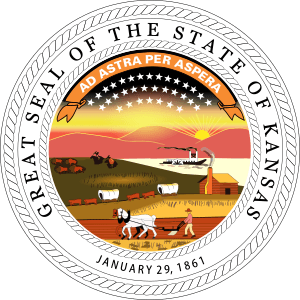
Kansas became the 34th state in the United States on January 29, 1861.
The 1860s brought many changes to Kansas. These included its role in the Civil War, the start of cattle drives, the beginnings of Prohibition, and the start of the Indian Wars on the western plains. James Lane was elected as a Senator from Kansas in 1861 and again in 1865.
Kansas in the Civil War
After years of small-scale civil war, Kansas joined the Union as a free state in 1861. Most Kansans strongly supported the Union. However, there were still guerrilla attacks and raids from pro-slavery forces, often from Missouri.
At the start of the war in April 1861, Kansas did not have a strong military. But its officials and citizens were united. Kansas raised 20,097 soldiers, more than its assigned number of 16,654. Kansas regiments had more soldiers killed in battle and by disease per thousand than any other state.
Besides small battles, there were 29 Confederate raids into Kansas. The most serious was the attack on Lawrence, Kansas on August 21, 1863, by guerrillas led by William Quantrill. This was partly in revenge for "Jayhawker" raids against pro-Confederate settlements in Missouri.
Lawrence Massacre
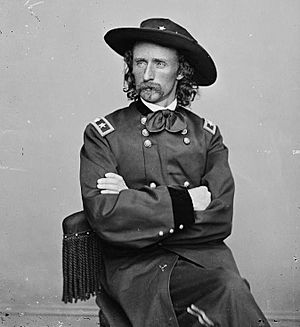
Union General Thomas Ewing Jr. ordered the imprisonment of women who helped Confederate guerrillas. Sadly, the jail roof collapsed, killing five women. These deaths angered guerrillas in Missouri. On August 21, 1863, William Quantrill led a raid into Lawrence. They burned much of the city and killed over 150 men and boys. Quantrill also said the attack was revenge for wrongs suffered by Southerners from jayhawkers.
Other Civil War Battles
The Battle of Baxter Springs was a small battle fought on October 6, 1863. The Battle of Mine Creek was a cavalry battle in Kansas. On October 25, 1864, the Battle of Marais des Cygnes happened in Linn County, Kansas. Union forces pushed Confederate Major General Sterling Price out of Kansas after he fled south from a defeat at Kansas City.
Indian Wars in Kansas
Fort Larned was built in central Kansas in 1859. It was a military base against Native American tribes on the plains. It also protected traffic on the Santa Fe Trail. After 1861, it became an agency for managing the Central Plains Indians.
Kansas Pacific Railroad
In 1863, the Union Pacific Eastern Division, later called the Kansas Pacific, was allowed by Congress to build a southern branch of the transcontinental railroad. The company also received large land grants along its main line. Construction began westward from Kansas City in September 1863.
| Date | Major Junctions |
|---|---|
| 1863 | Kansas City |
| 1864 | Lawrence |
| 1866 | Junction City |
| 1867 | Salina |
| 1870 | Denver |
After the war, many railroads were planned, but not all were built. The Panic of 1873 stopped funding. Towns that were reached by the railroad often grew, while others became ghost towns. In Kansas, nearly 5,000 towns were planned, but only 617 were still active by 1970.
Cattle Towns
After the Civil War, railroads did not reach Texas. So, cattlemen brought their herds to Kansas railheads. In 1867, Joseph G. McCoy built stockyards in Abilene, Kansas. He helped develop the Chisholm Trail, encouraging Texas cattlemen to drive their cattle to Abilene from 1867 to 1887. These stockyards became the largest west of Kansas City. Once the cattle arrived, they were shipped east by the Kansas Pacific Railway.
In 1871, Wild Bill Hickok became marshal of Abilene, Kansas. He was also a deputy marshal at Fort Riley and a marshal at Hays. In the 1880s, the Big Well was built in Greensburg, Kansas, to provide water for railroads. At 109 feet deep and 32 feet wide, it is the world's largest hand-dug well. Coronado, Kansas, founded in 1885, was involved in a bloody county seat fight in 1887, which left several people dead.
Exodusters
In 1879, after the end of Reconstruction in the South, thousands of Freedmen moved from Southern states to Kansas. They were called the Exodusters. They were attracted by the promise of good, cheap land and better treatment. The all-black town of Nicodemus, Kansas, founded in 1877, is often linked with the Exodusters.
Prohibition in Kansas
On February 19, 1881, Kansas became the first state to change its constitution to ban all alcoholic beverages. This was due to the temperance movement. Carrie A. Nation helped enforce this ban starting in 1888, sometimes using an ax to smash saloons. Kansas did not end statewide prohibition until 1948. Even then, public bars were still banned until 1987. Kansas did not allow Sunday liquor sales until 2005, and most areas still ban them. Today, 29 counties in Kansas are dry counties.
Religion in Kansas
Topeka played an important role in American Christianity around the early 1900s. Charles Sheldon, a leader in the Social Gospel movement, who first used the phrase What would Jesus do?, preached in Topeka. Topeka was also home to the church of Charles Fox Parham, who many historians connect with the start of the modern Pentecostalism movement.
Farming in Kansas
Environment and Farming Challenges
Early settlers learned that Kansas was not a "Great American Desert." However, they also found that the harsh climate, with tornadoes, blizzards, droughts, hail, floods, and grasshoppers, made farming very risky. Many early settlers lost their money. Especially in the early 1890s, they either joined the Populist movement to protest or moved back east. In the 1900s, crop insurance, new conservation methods, and federal aid helped lower the risks. Immigrants, especially Germans, were the largest group of settlers after 1860. They were drawn by good soil, cheap land from railroads, and the chance to get 160 acres for free from the government.
The problem of blowing dust happened because there was not enough rain to grow enough wheat to keep the topsoil from blowing away. In the 1930s, new soil conservation techniques were promoted. With better weather, soil conditions greatly improved by 1940.
Farm Life in Kansas
On the Great Plains, few single men tried to run a farm. Farmers knew they needed a hard-working wife and many children to help with chores. These chores included raising children, feeding and clothing the family, managing the house, feeding hired workers, and handling paperwork. In the late 1800s, farm women played a key role in helping their families survive by working outdoors. After a generation, women increasingly worked less in the fields and focused more on home duties. New inventions like sewing and washing machines helped this change.
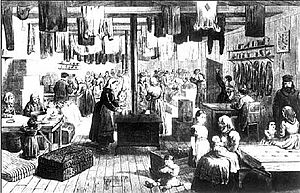
Even though farm life on the prairies might seem lonely, rural people created a rich social life. They often had activities that combined work, food, and fun. These included barn raisings, corn huskings, quilting bees, Grange meetings, church events, and school functions. Women organized shared meals and visits between families.
Agriculture Manufacturing
In 1947, Lyle Yost started Hesston Manufacturing Company. This company made farm equipment, such as machines for cutting hay. In 1991, AGCO Corporation bought Hesston Corporation, and farm equipment is still made in the city of Hesston today.
Kansas in the 1890s
In 1896, William Allen White, editor of the Emporia Gazette, wrote a famous article called "What's the Matter With Kansas?" He criticized Populist leaders for letting Kansas fall behind economically. He said their anti-business policies scared away money from the state. Republicans used this article to support William McKinley in the 1896 presidential election. While McKinley won in Kansas's small towns and cities, William Jennings Bryan won the farm areas and the state's electoral votes.
Kansas in the 20th Century
The Progressive Era
Kansas was a strong center for the progressive movement. Middle-class citizens, editors like William Allen White, and prohibitionists from the WCTU and the Methodist Church strongly supported it. White used his stories to talk about social change and the importance of community. He opposed chain stores and mail-order companies, seeing them as a threat to local businesses.
In 1916, Kansas troops served on the U.S.–Mexico border during the Mexican Revolution. When the United States declared war on Germany in April 1917, 80,000 Kansans joined the military. The state's large German population had favored neutrality and were closely watched. They were often forced to buy war bonds or not speak German in public.
In 1915, the El Dorado Oil Field was discovered near El Dorado. It was the first oil field found using scientific mapping. By 1918, it was the largest single oil field in the USA, producing 12.8% of the nation's oil and 9% of the world's oil. Some said it was "the oil field that won World War I".
While cities did well in the 1920s, the farm economy struggled. Wheat prices had been high during the war, leading to overexpansion, and then they dropped sharply.
Between 1922 and 1927, several legal battles against the KKK led to their decline in Kansas.
The flag of Kansas was designed in 1925 and officially adopted in 1927. The word "Kansas" was added in 1961. It was first flown by Governor Ben S. Paulen in 1927.
The Great Depression and Dust Bowl
The Dust Bowl was a series of dust storms caused by a huge drought that began in 1930 and lasted until 1941. The drought's effects were made worse by falling wheat prices and the financial crisis of the Great Depression. Many local banks closed. Some farmers left their land, but even more unemployed men left cities to return to their family farms.
Kansas eagerly joined New Deal programs like the Civil Works Administration and the Works Progress Administration. These programs put hundreds of thousands of Kansans to work. Most importantly, New Deal farm programs raised prices for wheat and other crops, helping the economy recover by 1936. Republican Governor Alf Landon also took emergency steps, like stopping mortgage foreclosures.
World War II and Beyond
Kansas greatly helped the war effort in World War II by increasing grain production. Farmers complained about price limits for wheat, production quotas, and a shortage of farm machinery. They also wanted young farmers to be excused from the draft.
Wichita, which had a history in aviation, became a major center for the aircraft industry during the war. It attracted many workers from farms and small towns.
The Women's Land Army of America trained farm wives in machine handling, safety, and time-saving methods.
Cold War Era
Kansas state law allowed segregated public schools. On May 17, 1954, the Supreme Court ruled in Brown v. Board of Education that separate schools for different races were unequal and illegal. The Monroe Elementary School in Topeka, one of the segregated schools for African American children, is now a historic site.
During the 1950s and 1960s, intercontinental ballistic missiles (missiles designed to carry nuclear warheads) were stored in underground silos throughout Kansas. These facilities were closed in the early 1980s.
On June 8, 1966, Topeka, Kansas was hit by a powerful F5 tornado. The "1966 Topeka tornado" started on the southwest side of town and moved northeast, hitting places like Washburn University. The total cost of damage was $100 million.
Famous Kansans
Kansas is home to President Eisenhower from Abilene, presidential candidates Bob Dole and Alf Landon, and aviator Amelia Earhart. Famous athletes from Kansas include Barry Sanders, Gale Sayers, Jim Ryun, Walter Johnson, Maurice Greene, and Lynette Woodard.
Sports in Kansas
The Kansas Sports Hall of Fame tells the story of competitive sports in the state.
College Sports History
Kansas has many important firsts in sports history. The first college football game in Kansas was played in Baldwin City in 1890 between Kansas and Baker. Baker won 22–9. The first night football game west of the Mississippi River was played in Wichita, Kansas in 1905.
In 1911, the Kansas Jayhawks played the Missouri Tigers in what is thought to be the first homecoming game ever. The first college football homecoming game ever televised was played in Manhattan in 1939.
In 1951, Southwestern coach Harold Hunt gained national attention. In a game against Central Missouri, he told officials that his player had stepped out of bounds, canceling a long touchdown run. A photo later proved Coach Hunt was right.
On October 2, 1970, a plane carrying about half of the Wichita State football team crashed on their way to a game. 31 people died. The game was canceled, and the Utah State football team held a memorial service.
Professional Sports History
Professional sports in Kansas likely began with the Minor League Baseball Topeka Capitals and Leavenworth Soldiers in 1886. Bud Fowler, an African-American player, played on the Topeka team that season, one year before the "color line" (which banned black players) started in professional baseball.
In 1887, a new Topeka team, the Golden Giants, dominated the league. They had many major league players and won the league by a large margin. On April 10, 1887, the Golden Giants even beat the defending World Series champions, the St. Louis Browns, in an exhibition game. However, Topeka could not support the team, and it disbanded after one year.
The first night game in professional baseball history was played in Independence, Kansas, on April 28, 1930. The Muscogee (Oklahoma) Indians beat the Independence Producers 13 to 3 in a minor league game.
Images for kids
-
John Brown around 1856.
-
Boeing B-29 Superfortress production in Wichita in 1944.
See also
 In Spanish: Historia de Kansas para niños
In Spanish: Historia de Kansas para niños



